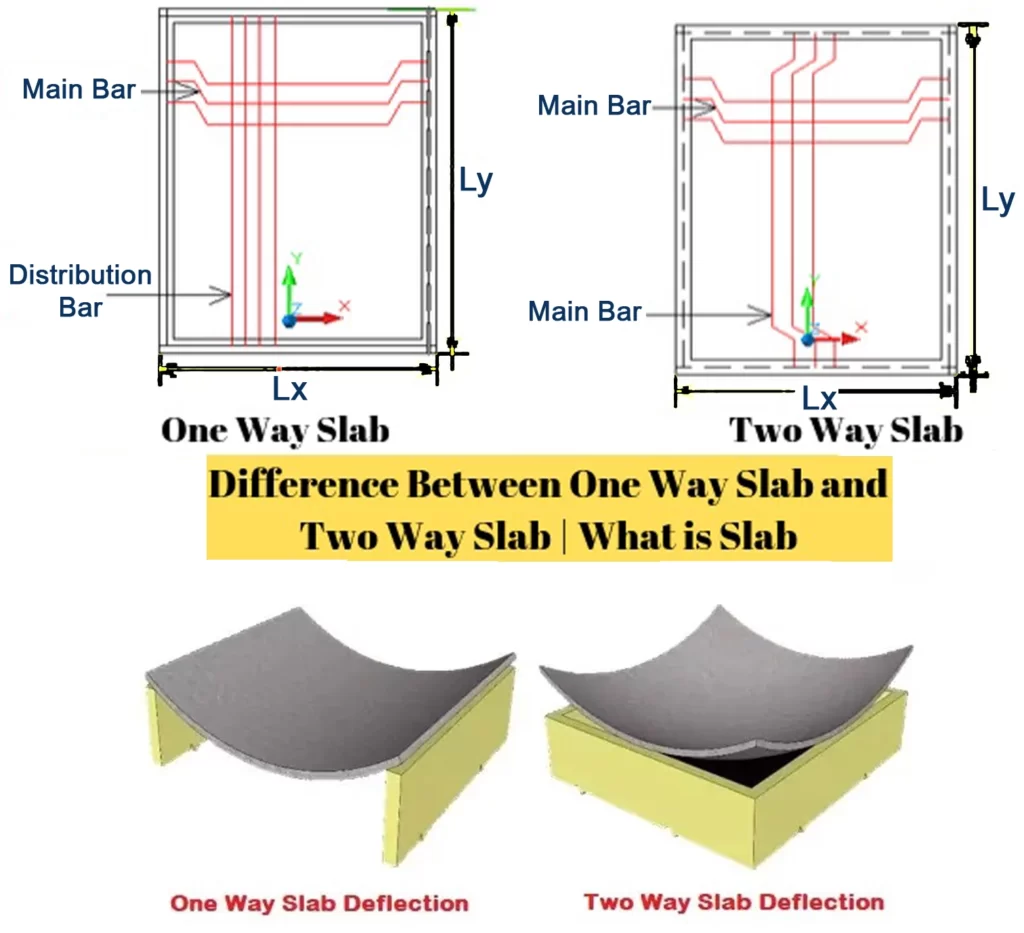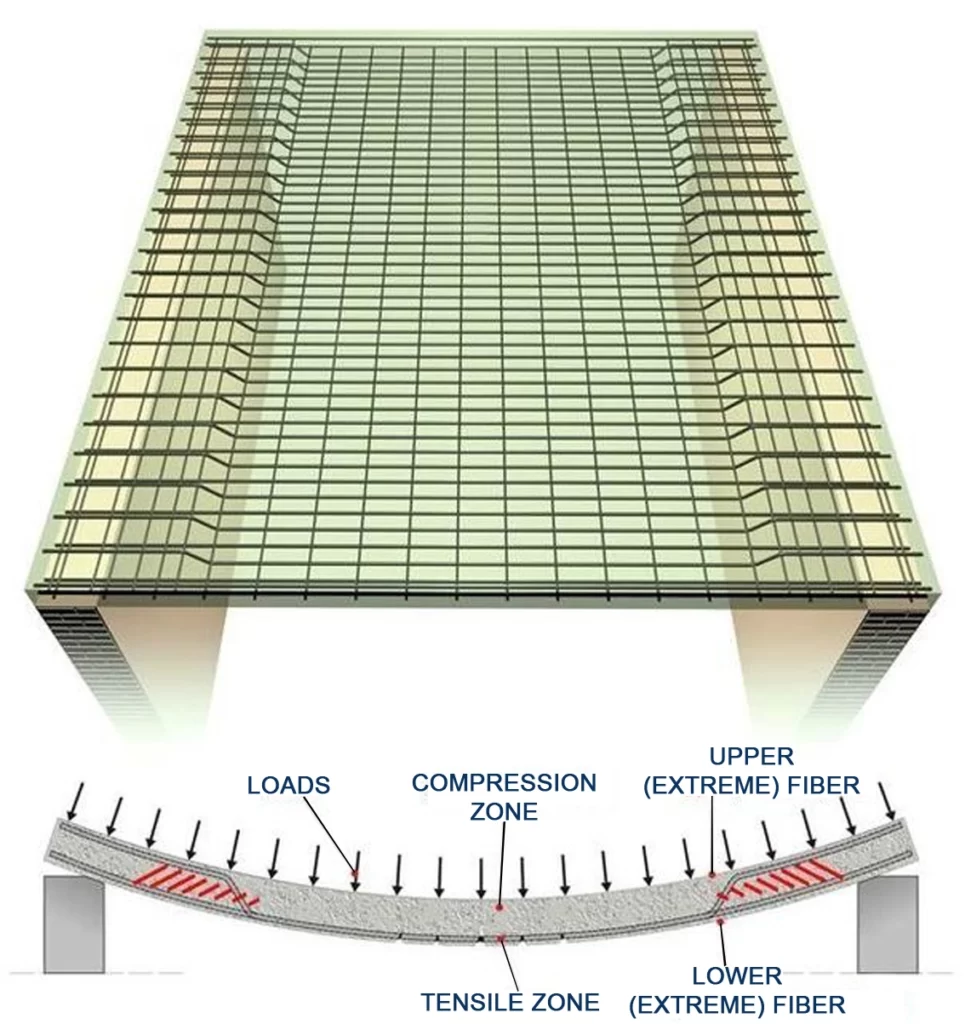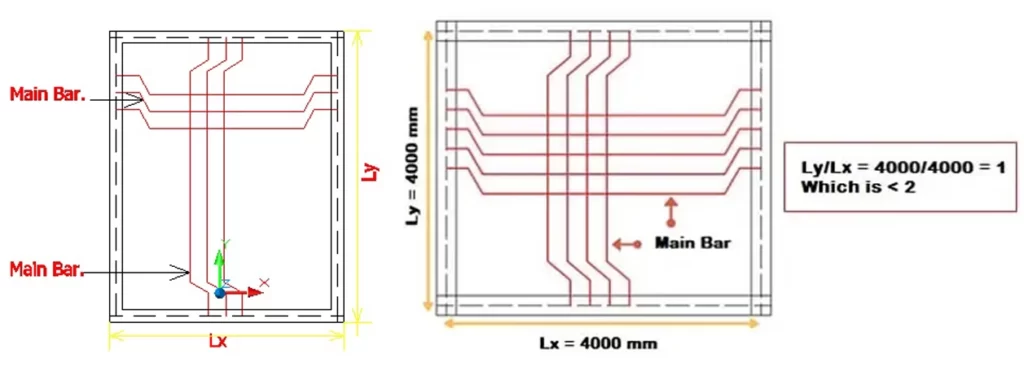If you want to know about the ceiling finishes or gypsum ceiling or tile flooring, please click the link.
Introduction
Slabs are an integral part of construction and play a crucial role in providing structural support to buildings and other structures. In simple terms, a slab is a horizontal, flat, and usually reinforced component that forms the floors, roofs, and ceilings of a building.
It acts as a load-bearing element, transferring the loads from the superstructure to the supporting beams, columns, and walls.

Importance of Slabs in Providing Structural Support
Slabs are essential for maintaining the stability, strength, and overall integrity of a structure. Here are some key reasons why slabs are of utmost importance in construction:
- Load Distribution: Slabs efficiently distribute the applied loads, such as the weight of occupants, furniture, and equipment, over a larger area. They help evenly distribute the loads to the supporting elements, preventing localized stress concentrations and ensuring structural stability.
- Bearing Surface: Slabs provide a solid and level surface for people to walk on, place furniture, and perform various activities within a building. They offer the necessary support for comfortable living and working environments.
- Structural Connectivity: Slabs connect the vertical elements of a structure, such as beams, columns, and walls, providing a unified and interconnected system. This connection enhances the overall strength and rigidity of the building, enabling it to withstand various forces, including gravity, wind, and seismic loads.
- Reinforcement Integration: Slabs can be reinforced with steel bars or mesh to enhance their load-carrying capacity and resistance to cracking. The reinforcement helps control deflections, improve durability, and increase the overall structural performance of the building.
- Thermal and Acoustic Insulation: Slabs contribute to the thermal and acoustic insulation of a structure. By incorporating insulating materials within the slab or using techniques like double-layered slabs, heat transfer and sound transmission can be reduced, resulting in improved energy efficiency and occupant comfort.
- Flexibility in Design: Slabs offer flexibility in design by allowing different configurations and spans. They can be tailored to meet specific architectural and functional requirements, accommodating various room layouts, open spaces, and architectural features.
In conclusion, slabs form the foundation for the construction of floors, roofs, and ceilings, playing a vital role in providing structural support.
They ensure load distribution, create bearing surfaces, enhance connectivity, integrate reinforcement, provide insulation, and offer design flexibility.
Understanding the importance of slabs is crucial for architects, engineers, and construction professionals to ensure safe and resilient structures.
1) What Is Slab?
Slab is an important structural element generally constructed horizontally to provide flat surfaces such as roof, ceiling, floor, etc. Slabs may be supported by RCC beams, columns, steel beams, etc.
Basically, the depth of a slab is very small compared to its depth. There are mainly two types of slabs, i.e one way slab and two way slab.
One Way Slab
A one-way slab is a type of structural slab that is designed to primarily resist the loads in one direction. It is supported by beams or walls on two opposite sides, resulting in a longer span in one direction compared to the other.
One-way slabs are commonly used in buildings where the load is primarily applied in a single direction, such as in typical floor slabs.

One way slab is a slab which is supported by beams on the two opposite sides to carry the loads along one direction.
In one way slab, the ratio of longer span (l) to shorter span (b) is equal or greater than 2, i.e ( Longer span (l)/Shorter span (b) ≥ 2 ).
Verandah slab is a type of one way slab, where the slab is spanning in the shorter direction with main reinforcement and the distribution of reinforcement in the transverse direction.
Here are some key characteristics and features of one-way slabs:
- Load Distribution: One-way slabs are designed to distribute the applied loads primarily in one direction, typically along the shorter span. The load is transferred to the supporting beams or walls, which then carry the load to the vertical elements of the structure.
- Reinforcement Placement: The reinforcing steel bars, also known as rebar, are placed in the one-way slab in the direction perpendicular to the load-carrying direction. The rebar helps to enhance the slab’s strength and resistance to bending and cracking.
- Structural Behavior: One-way slabs behave as beams in the direction perpendicular to the load-carrying direction. They primarily resist bending and flexural forces. The longer span of the slab is generally considered as the simply supported span, while the shorter span is considered as the span between the supporting beams or walls.
- Span-to-Depth Ratio: The span-to-depth ratio is an important design consideration for one-way slabs. It influences the slab’s strength, deflection, and overall performance. Design codes and guidelines provide specific span-to-depth ratios to ensure structural integrity and serviceability of the slab.
- Construction Process: The construction of one-way slabs typically involves the use of formwork, which is the temporary mold that shapes the concrete during pouring and curing. The formwork is supported by beams or walls along the longer span. Reinforcement is placed within the formwork before pouring the concrete.
- Applications: One-way slabs are commonly used in buildings where the layout and load distribution primarily follow a single direction, such as in residential and commercial floor slabs. They are suitable for situations where the load is predominantly concentrated along one axis, allowing for a more efficient structural design.
It’s important to note that the design and construction of one-way slabs should adhere to local building codes and standards to ensure safety and structural stability.
Engineers and architects consider factors like loads, span lengths, material properties, and construction methods to determine the appropriate design and reinforcement detailing for one-way slabs.
One Way Slab Reinforcement Details
In one way slab, as one side is larger than the other one, the maximum load will be conveyed by the larger side. Therefore it is important to provide adequate support to this side.
To provide adequate support to the longer side, the main reinforcement bars are provided parallelly to the shorter side and the distribution bars are provided on the longer side which won’t help in carrying the load.

In the above slab, Larger span/Shorter span = Lx/Ly = 4500/2000 = 2.5 Which is > 2.
So it is a one way slab. In this slab, the main reinforcement bars are provided on the shorter side and distribution bars are provided on the longer side.
Two Way Slab
A two-way slab is a type of structural slab that is designed to resist loads in both directions. Unlike a one-way slab, which is supported by beams or walls on two opposite sides, a two-way slab is supported by beams or walls on all four sides. This results in a relatively shorter span in both directions.

When a reinforced concrete slab is supported by beams on all the four sides and the loads are carried by the supports along with both directions, it is known as two way slab. In two way slab, the ratio of longer span (l) to shorter span (b) is less than 2. ( i.e Longer span (l)/Shorter span (b) < 2 ).
These types of slabs are mostly used on the floor of multi-storey buildings.
Here are some key characteristics and features of two-way slabs:
- Load Distribution: Two-way slabs are designed to distribute the applied loads in two directions, typically along both the longer and shorter spans. The load is transferred to the supporting beams or walls, which then carry the load to the vertical elements of the structure.
- Reinforcement Placement: The reinforcing steel bars, or rebar, are placed in a two-way slab in both directions to provide strength and resistance to bending and cracking. The rebar is typically placed in a grid pattern, forming a mesh of bars in both the longitudinal and transverse directions.
- Structural Behavior: Two-way slabs distribute the load through a combination of bending and membrane action. They behave as flat plates and transfer the load to the supporting elements in a more uniform manner compared to one-way slabs. The load distribution is influenced by the stiffness and rigidity of the slab and its supporting structure.
- Aspect Ratio: The aspect ratio of a two-way slab refers to the ratio of the longer span to the shorter span. It is an important design consideration that affects the slab’s structural behavior, deflection, and load-carrying capacity. Design codes and guidelines provide specific aspect ratio limits to ensure structural performance.
- Construction Process: The construction of two-way slabs involves the use of formwork, which provides the temporary mold for shaping the concrete during pouring and curing. The formwork is supported by beams or walls on all four sides. Reinforcement is placed within the formwork in a grid pattern before pouring the concrete.
- Applications: Two-way slabs are commonly used in buildings where the layout and load distribution require support in both directions, such as in large floor areas, parking structures, and commercial buildings. They are suitable for situations where the loads are distributed more evenly and where the span lengths are relatively shorter.
Proper design and construction practices are crucial for the performance and safety of two-way slabs.
Engineers and architects consider factors like loads, span lengths, aspect ratio, material properties, and construction methods to determine the appropriate design and reinforcement detailing for two-way slabs.
Compliance with local building codes and standards is essential to ensure structural integrity and durability.
Two Way Slab Reinforcement Details
In two way slab, as the loads are carried in both directions (longer and shorter direction) main reinforcement bars are provided in both directions.
The loads are carried by two sides are equal. Slab with reinforcement in both directions is more economical than one way reinforcement slabs.

In the above slab, the ratio of longer span to shorter span i.e ( Lx/Ly = 4000/4000 = 1 Which is < 2 ). So it is a 2 way slab. You can see the main bars (Crank bars) are provided on both sides.
2) Difference b/w one way slab & two way slab
| One Way Slab | Two Way Slab |
| The slabs are supported by the beams on the two opposite sides. | The slabs are supported on all the four sides. |
| In one way slab, the load is carried in one direction perpendicular to the supporting beam. | In two way slab, the load is carried in both directions. |
| One way slab two opposite side support beam /wall | Two Way Slab four side mins all side supported beam /wall |
| One way slab is bend only in one spanning side direction while load transfer | Two way slab is bend both spanning side direction while load transfer |
| One way slab is bend only in one spanning side direction while load transfer | In two-way slab, the crank is provided in four directions. |
| If L/b the ratio is greater than or equal 2 or then it is considered a one-way slab. | If L/b the ratio is less than 2 then it is considered a two-way slab. |
| In one-way slab, the load is carried in one direction perpendicular to the supporting beam. | In two-way slab, the load is carried in both directions. |
| The deflected shape of the one-way slab is cylindrical. | Whereas the deflected shape of the two-way slab is a dish or saucer-like shape. |
| Chajja and Varandha are practical examples of one-way slab. | Whereas two-way slabs are used in constructive floors of the Multistorey building. |
| In one-way slab quantity of steel is less. | In two-way slab quantity of steel is more as compared to the one-way slab. |
| Main Reinforcement is in provide short span due to banding. | Main Reinforcement is in provide short span due to banding |
| Ly/Lx ≥ 2 one way slab spanning. | Ly/Lx < 2 two way slab spanning |
| One way slab near about 100mm to 150mm based on the deflection. | Two way slabs is in the range of 100mm to 200mm depending upon |
| One way slab economical near about 3.5 m. | Two way slab may economical for the panel sizes near about 6m x 6m. |

3) Conclusion
In conclusion, understanding the key differences between one-way slabs and two-way slabs, and selecting the appropriate slab type based on project requirements, is crucial.
Proper design and construction practices play a vital role in ensuring the structural integrity, efficiency, and safety of the slabs.
Consulting with qualified engineers and following best practices throughout the construction process is essential for successful and resilient slab structures.